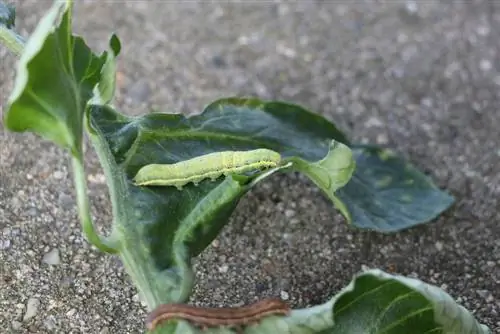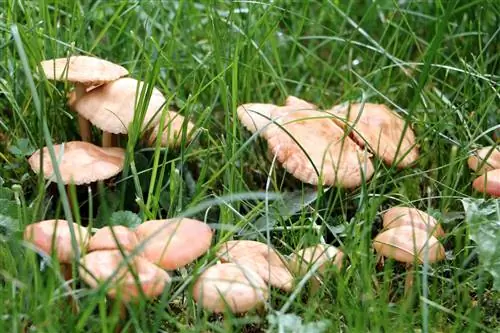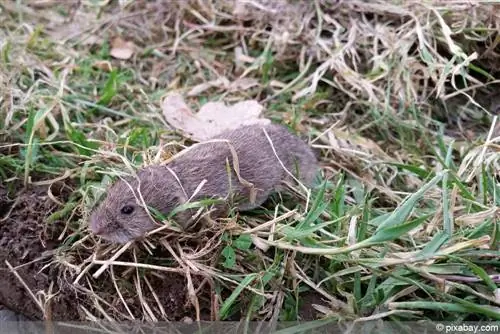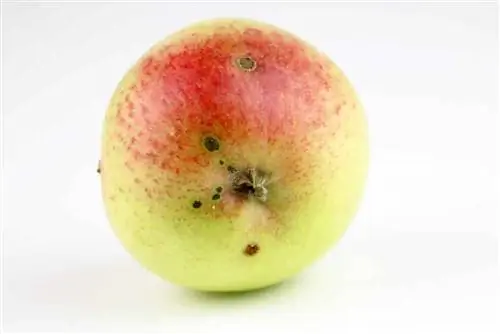- Author admin [email protected].
- Public 2023-12-17 03:39.
- Last modified 2025-01-24 12:45.
It happened quickly. A few days of inattention or non-presence and caterpillars have spread throughout the local plant world. If a severe infestation can no longer be denied, the fight can still be started with some traditional home remedies before resorting to chemicals. They do not always lead to success, as the many possible species of caterpillars react differently to the application of the product. Before the massive use of chemical poisons, it's definitely worth trying, and it's cheaper.
Water pressure
Some species of caterpillars can appear in large numbers, but do not have particularly strong holding properties. The controller can take advantage of this by using a sharp jet of water to wash the caterpillars off the leaves and stems. The key to success is thoroughness and removing the fallen caterpillars, which would otherwise find their way back onto the plant.
soft soap
One of the best-known old home remedies is soft soap, which is dissolved in water and filled into a spray bottle. The affected plants are sprayed generously several times, leaving enough time between each spraying process for the soapy water to dry. Not all caterpillar species react to this, so the “trial and effect” principle must be used. It should be noted that only oil- and fat-free soaps such as pure curd or soft soap may be used, as oil-containing products harm the plants by clogging their pores.
Hairspray
A purely mechanical and labor-intensive control is collecting the caterpillars. Conventional hairspray is suitable for preparatory fixing of the caterpillars, which are then collected from the leaves and branches by hand, wooden tongs or another fine gripping tool. The prerequisite is that all parts of the plant and sides are easily accessible. It should be noted that not all plants tolerate being sprayed with hairspray. While trees and many shrub species are insensitive to this, flowering and potted plants can suffer damage caused by restricted respiration and photosynthesis ability.
Tobacco
Most animals are repelled by the smell of tobacco. This can also be used to combat caterpillars. The dosage is important so that the plants themselves do not suffer any damage. Before using the tobacco and nicotine method, it must be clarified how the caterpillar species reacts to these substances. There are individual species of caterpillars that can even use nicotine to ward off natural enemies such as birds or spiders. If this is not the case, tobacco ash can be scattered on the moistened leaves of the affected plants to scare the caterpillars away. Evaporating the plants with exhaled nicotine smoke also drives away the caterpillars, but is difficult to do in practice.
Garlic and seaweed lime
Garlic and algal lime, which almost all caterpillar species detest, also work on the olfactory level. The two products are primarily recommended as preventative measures to prevent caterpillar infestation. It is still worth testing the effect if an infestation has already occurred. Garlic and algae lime can successfully prevent the caterpillars from returning, especially in combination with another type of mechanical control. Planting garlic between infected plants can cause the caterpillars to retreat, which is further promoted by dusting the leaves with garlic powder or algae lime.
Glue
A classic protective tool for preventing caterpillar infestation is the glue ring, which is attached to fruit trees, for example, to block crawling caterpillar species. The principle of gluing with glue can also be used if there is already an infestation. Depending on the type of plant and growth habit, the caterpillars’ “logistical” paths can be interrupted and blocked. Insurmountable and constantly freshly glued glue rings in strategically thought out places prevent the caterpillars from migrating to the nearest feeding grounds such as further foliage. After the caterpillars on the leaves are mechanically removed, the “supply route” is severed.
Parasitic wasps
Parasitic wasps are primarily known as biological moth control agents and in fruit growing. There are now also more bred and specialized species that are helpful against caterpillar infestation. The parasitic parasitic wasps lay their eggs in the caterpillars and anesthetize them. The stunned caterpillars can then be more easily removed mechanically by collecting or vacuuming. However, the use of parasitic wasps should only be carried out after extensive work and information gathering in advance. Biological interactions and botanical consequences can mean that caterpillar control, if implemented incorrectly, can result in other life-threatening risks for the plants.
Natural insecticides
In addition to chemical insecticides, there is the naturally occurring bacterium “Bacillus thuringienses”, which is primarily used to combat mosquitoes. Special mixtures of the bacterium in so-called Bt suspensions are produced to combat caterpillars.
Suction
The caterpillars can be vacuumed from the plants with a special vacuum cleaner. Garden centers and authorities for green spaces and facilities usually have these specialized vacuum cleaners. Strong industrial vacuum cleaners can also be used under certain circumstances if they have adjustable suction power.
Burn down
Especially in the case of caterpillar species that are harmful to he alth (see tip), the caterpillar nests and caterpillars are burned down with special “flame throwers”. However, this method may only be used by professional gardeners and pest controllers as the risk of fire and damage is very high.
Frequently asked questions
How do I determine the type of caterpillar?
There are a large number of picture galleries on the Internet that list all the species of caterpillars that occur. If you are unsure or are looking for professional advice on effective control, contact a nursery or your local authority for gardens, green spaces and parks with a sample copy.
Are there also harmless caterpillars?
There are even more species of caterpillars that pose no danger to your garden and plants. Many species feed exclusively on rarely cultivated plants such as nettles or wild herbs. Some caterpillars must not be controlled because they are the larvae of protected butterfly species.
Editor’s Tip
Processionary moth and goldworm caterpillars with stinging hairs are special cases whose stinging hairs can cause skin irritations and even allergic reactions. An infestation should definitely be reported to the responsible green space or he alth authority.
What you should know about caterpillar control in brief
- If you intervene as soon as a caterpillar infestation begins, combating it is easy. A few sprays of pesticides are usually completely sufficient. But you should only do this if there is a risk that the pests will multiply on a mass scale.
- For now you can also collect the caterpillars and either move them or use them as bird food.
- You should be careful with preparations containing oil. They often cause more harm than good. They glue the leaf columns together. This can lead to complete defoliation. These products should only be used for prophylactic purposes, in the spring before the leaves begin to sprout.
- Old home remedies often prove to be very effective against pests and are also he althy for nature. For example, you can get rid of caterpillars on berry bushes and vegetables by spraying the plants with soft soapy water.
- Sprinkling damp bushes with tobacco ash or soot often helps. Many caterpillars don't like garlic. You can protect your vegetables by simply planting garlic between them. Algae lime also works against caterpillars. You simply sprinkle it under infected plants.
- It gets annoying when whole hosts of caterpillars attack the fruit trees. Collecting them is no longer enough, there are too many. Before you start using chemicals, you can first try using glue rings. These help against all crawling pests. The glue rings should be green, as white glue rings also attract beneficial insects.
- To prevent the caterpillars of the voracious cabbage white butterfly, it is best to cover your cabbage beds with fine-mesh nets to prevent the butterflies from laying their eggs between May and June.
- Otherwise, a mixed culture with tomatoes and celery also helps. You can also plant the edges of the bed with herbs, such as dill, sage, rosemary, thyme, peppermint and mugwort.
- If all else fails, you should resort to pesticides or pesticides. You shouldn't choose a remedy at random, but rather seek advice. As a rule, a spray agent is used.






